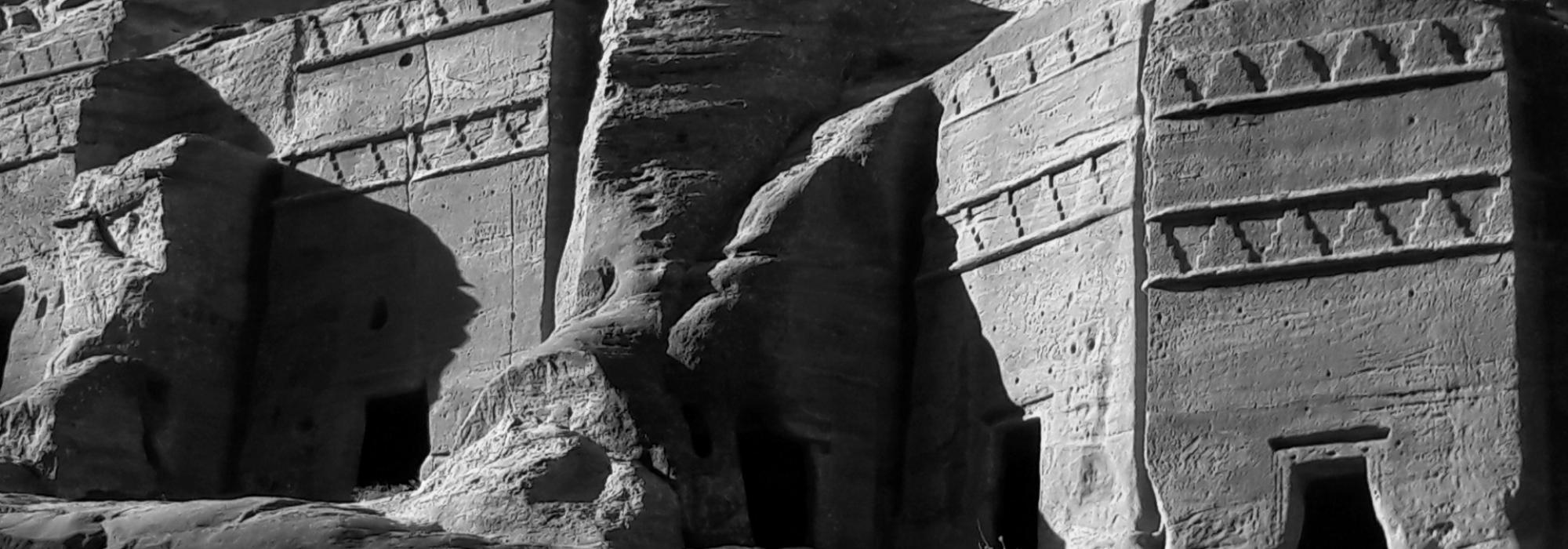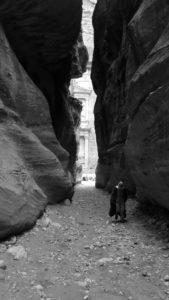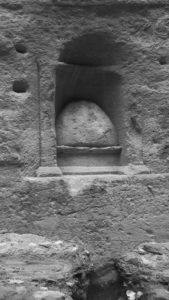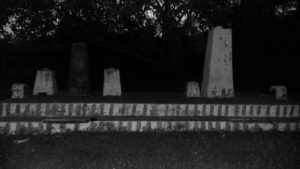Petra is a UNESCO world heritage site, three hours from Jordan’s capital, Amman. We enter it through a Siq (pronounced ‘seek’) – a narrow, naturally-formed sandstone gorge that is 2 km long that suddenly opens into the imposing “treasury building.” A road between the Dushare mountains takes you to the street of the façades, with nearly a hundred façades carved into the sandstone gorge on either side. Travel further and you cross Roman remains and finally after an hour’s climb reach the breathtaking façade of the “monastery.”
All these tombs are carved into the sandstone and date between 1st century BCE and 1st century CE. They were built by the Nabateans. The Nabateans had their own gods till around the 3rd century CE when they converted to Christianity. In the 3rd century, an earthquake flattened out most of Petra; the Siq we enter through was blocked with stones and Petra was abandoned. Subsequent travelers who crossed it either plundered what little was left or camped in the caves during the harsh weather.
Gouging out sandstone to create façades and thirty-feet-high rooms was expensive even for a king’s tomb. The Nabateans were wealthy. Through stucco lined canals and filter chambers, they harvested every inch of the 5-7 in. of rain the local area gets. They also owned the spring in Wadi Musa and sold water to traders and caravans along the old silk and spice routes in addition to a tax of as much as 25%. If they foresaw war with neighbors—Romans, Assyrians, or Egyptians—they quickly negotiated commercial settlements. They were commercially astute rulers who figured out how to win the game of politics using economics.
Luck ran out for them after three centuries when the Romans captured them in 106 CE and made Petra their Arabian capital. However, when they moved the Roman capital to Byzantine from Rome, they moved the Silk and Spice routes up northwards to Bostra. Petra was marginalized and the earthquake of the 6th Century pretty much reduced it to a ghost town.
The Indian connection
India was not on my mind as I walked through the Siq admiring the rose red sandstone glinting in the sunlight and the many bas reliefs or baetyls on the wall. One of them, my guide told me, was Shiva.
Shiva? I scoffed at him, for it looked nothing like Shiva. This must be a stunt for him to get some tips from an Indian visitor. It is likely that the Nabateans traded with India but it seemed impossible to me that they would put a Hindu deity in their city.
Shiva however had other plans, and the guide’s mention of him resulted in Shiva remaining in my active conscious mind. Everything I saw after that was breathtaking but now I saw through the lens of an avid researcher of Hindu philosophy and cave temple architecture. I saw many parallels between the ancient pagan cultures. Three interesting similarities in thought emerged.
Symbolism in the motifs
The Nabateans quickly moved from nomadic traders to landed aristocracy. They were anxious that their tombs reflect their new role and their connections with the empires around them. Classical Greek motifs predominate as well as Assyrian motifs. A recurrent motif was: three vertical lines and a circle. The motif was difficult to capture on a phone camera but all the new metal barriers and road dividers in the area have the same motif! My guide explained that it stood for how life is divided into birth, life, and death and the circle indicates that these are but an ever constant cycle.
Compare this with one of the fundamental uniting principles of Hinduism or Sanatana Dharma as it ought to be called. We may disagree with our sacred texts, deities, and their messengers, but this belief in life as a cycle is a uniting and basic belief. So much so that our concept of time—before we adopted the Gregorian linear system was cyclical—with every ‘year’ repeating once every 60 years. Sadly the Nabateans left very few written records. But in an area that is the bedrock of Abrahamic religions, this was an interesting observation.
Cave construction
Comparing the Nabateans tombs to Pallava and Pandya caves that came more than five centuries later is an interesting study of contrasts. All Nabateans caves are tombs, while none of our cave temples have any connection with tombs. We have our own tombs but they were from a different century and an influence.
Petra’s sandstone may have been easier to gouge out than our granite but the precision and scale are impressive. Most interiors, especially in the street of façades, are a roomy 30 ft. x 30 ft. x 30 ft. Compare these to our cave temples which are usually less than 50% of that; and never more than 12 ft. in height. Petra’s tombs have smoothly finished ceilings unlike the rough-cut ones of our caves. In our caves, there are several motifs, bas reliefs, and inscriptions. Petra has just plain walls, sometimes a few alcoves or remnants of sarcophagi and square holes in the walls that would have had wooden logs that supported lamps or incense burners.
Unlike the Jain cave at Sittanavasal, many of our caves lack acoustical properties. Most of Petra’s tombs have acoustical properties. I recited some mantras from the Rigveda Samhita and they were distinctly audible for at least 15 ft. outside despite howling winds!
Our method of cave construction as made out from half-finished projects was to cut grids on the rock face and then carve from outside. Their method was to make a small square hole in the top, and then build from above, rather like how the Ellora and Shore temple were built; but they never tried free standing structures.
Cave temples in Maharashtra however, compare in size to Petra especially those in Bhaja, near Pune that date from the 2nd Century. The caves like in Petra held relics of monks and Bhaja itself was on the old trade routes. Several of the caves have an opening above the doorway but they seem to perform a ventilation purpose. Or were they?
Shiva’s presence
By the 1st century CE when the last of the tombs were being excavated, Shiva had already assumed the form we see today. Shiva means “auspicious.” He is an amalgamation of deities like Pasupata and Rudra (the one who howls) a terrifying deity causing death and disease among sinful men and cattle. Agni who is found in sun, lightening, and fire (and therefore ‘Trayambaka’) was also a part of Shiva. Our earliest Shivalingam is dated 1st Century BCE from Bhitta (now in the Lucknow museum). However, from Vedic times, Shiva has represented as a column of light or as a lingam.
A recurrent motif in the Petra tombs is an obelisk that represents a funeral symbol. A tomb before the Siq has four of them prominently in its façade. One of the tombs in the royal tombs has them etched inside. Egypt has many of them. Several thousand kilometers away from Petra in the southern part of Tamil Nadu in Tirunelveli and adjoining areas, even today, on the roadsides one can see obelisk shaped memorial stones. Some are plain, others have a lamp over them, and some others a bas relief of the sun and moon that suggest that the glory of the departed soul will be remembered as long as the sun and the moon are in the sky.
Elsewhere in India, hero stones are usually obelisk-shaped, though the slopes on the sides vary. I felt that the coincidence was uncanny. Rudra, the Vedic deity, is closely connected to death. Even today, the most devout Vishnu worshipers, worship Shiva and especially Rudra as they cremate the body and seek Rudra’s intervention to protect the burning corpse from his bhutaganas (army of ghosts and ghouls), jackals, and other flesh eating creatures of the cremation ground. Bhairava’s association with death and Shiva as the guardian of the southern quarter that is the land of the deceased are also in common parlance. Perhaps it is not far-fetched that the baetyls on the Siq have Nabatean deities while the obelisk is a modified form of the lingam of our part of the world.
Supporting evidence
Why is this plausible? We have several references to trade between the south of India and the Arab countries. Even as late as the 16th century carvings of Arab traders are similar to the ones in Nabatean Petra. Travelers would have traded Indian goods as well as tales and mythology and vice versa. Sadly, less than 10% of Petra has been excavated, the rest of the secrets are still hidden. Our cave temples have been well-explored and will not give further proof. Our literature can only help with trade connections. The similarities between the obelisks and Shiva and Death are interesting. The contrast in cave excavation is interesting and irrespective of whether we can establish a connection it is fascinating that two kingdoms connected by trade, removed by distance have such startling similarities.
Ruminate on this as you travel to Petra in real or virtually and meditate on this as you enjoy your hike or donkey-ride across the lesser traveled eastern exit to Wadi Moosa.
Photographs by Suresh Krishna and the author.
For further exploration:
Poetry in Stone: How did they manage to cut into rock?
Elements of Hindu Iconography by T A Gopinatha Rao



















































Comments